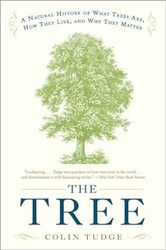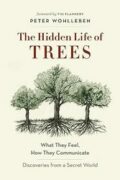
Rating: 8.0/10.
The Tree: A Natural History of What Trees Are, How They Live, and Why They Matter by Colin Tudge
Book about biology of trees and forests, containing scientific details of their evolution, lifecycle, and classification. Compared to “The Hidden Life of Trees,” this one is more scientific and denser, but is still written at a level suitable for a non-specialist. The middle section contains ~200 pages of classifications of hundreds of different tree species and their characteristics – this part is the most difficult, but it could be interesting for those who are particularly interested in tree species.
There are approximately 60,000 different tree species, many of which do not share any evolutionary lineage and come from different ancestors. It is not clear when trees are different or the same, as there are many hybrid cases, but most tree species exist in the tropics, where diversity is highest. Linnaeus proposed a hierarchical categorization of all living things, and Darwin’s theory of natural selection proposed that everything traces back to a common ancestor. However, in practice, it is quite difficult to determine exact groupings, whether by physical features or DNA, and species are often found to be miscategorized.
The first land plants were simple mosses (bryophytes), which could reproduce asexually and produced spores, surviving only in wet environments. About 360 MYA, plants first evolved seeds and alternation of generations, leading to all modern trees descending from these early plants. Some ancient trees (lycophytes) did not produce seeds and have long been extinct. Generally, tree trunks grow outward, with the outer layers transporting nutrients from the roots to the leaves, while the inner layers, though dead, provide structural support. There is a lot of diversity in the type of wood produced, growth speed, flexibility, etc.
The first group of trees the book examines are the conifers, which are distinguished by having seeds in their cones instead of flowers. They tend to be most common in northern latitudes, and their wood is generally softer than that of flowering trees. The most common families are pines (including spruces, cedars, and hemlocks), forming the northern boreal forests. The second most common family includes cypresses and redwoods. Some other rare species exist, including one called Wollemi, which is a rare tree found only in one stand in a remote place in Australia and is considered a living fossil because it was thought to be extinct for millions of years.
The angiosperms, or flowering plants, are characterized by having flowers and performing a complex process of double fertilization, which does not exist in any other living organisms. They evolved about 145 MYA, and flowers are evolutionarily unrelated to cones. Magnolia and water lily are the most primitive angiosperms (not necessarily the simplest, but the closest to the ancestral state), categorized by having very symmetrical flowers. Within the angiosperms, there are monocots and dicots, which have narrow leaves and broad leaves, respectively. The monocots include palm trees and bamboo, which generally have narrow leaves, and their trunks do not get thicker as the tree grows taller, staying the same width.
The dicots mostly fall under two categories. The rosids include roses, but also many trees and a wide range of other species, such as rubber, oak, beech, eucalyptus, maple, and mahogany. Many of these have nitrogen-fixing bacteria in their roots. The other group of dicots is the asterids, named after the daisy family, which includes many non-tree plants like tea and coffee, as well as some trees like teak and olive. Genetic studies have traced the lineage within each family and subfamily, but within each category, there are many species that are not physically similar at all: many non-trees closely related to tree species that look nothing like each other. This is an example of convergent evolution, where different paths lead to similar tree-like forms. This taxonomy section is quite a slog to read, at about 200 pages of tree classifications and a paragraph to a page or so about each of several dozen tree families, and many of the descriptions are very similar.
Moving on from tree taxonomy, the next section discusses the biology of trees. Trees absorb water from the soil, which is drawn up by evaporative pressure from the leaves. They require nitrogen, phosphorus, potassium, and sulfur; some have nitrogen-fixing bacteria in their roots, and another common symbiotic relationship is fungal extensions in the roots. Trees use hormones to communicate within themselves, for example, to determine which side is facing away from the light and needs to grow roots. Additionally, the timing of flower growth or leaf shedding is determined by the length of day and night, which is more consistent than weather. Since the plant measures the length of the night, it can be affected by a flash of artificial light during the night.
There are several theories about why trees are more diverse in the tropics. First, the higher energy levels in general mean that the pressure to survive is not due to the environment (being cold, lack of nutrients) but instead due to other living species, like parasites. Diversity also leads to more diversity since it creates niches related to specific species. Another reason is history, as the recent ice ages in temperate regions led to extinctions, resulting in less diversity, whereas the tropics were not affected. Trees have different strategies for forest fires: the quaking aspen has roots that can survive some fires and grow identical clone trees from the roots; jack pine cones are very fire-resistant and can sometimes open only in fire, allowing them to quickly occupy the nutrient-rich soil.
Trees primarily use sexual reproduction, which is essential for genetic diversity, although some trees can reproduce asexually or through cloning. This asexual reproduction results in vulnerability to disease and parasites when all members of a population are genetically identical. However, the drawback of sexual reproduction is that it requires finding and pollinating with a different member of the species. Most trees rely on wind or animals for fertilization, using flowers or fruits that are eaten and deposited at a distance. A special example is figs, which have a symbiotic relationship with wasps. The wasps lay eggs inside the figs, and their offspring grow up within the fig; when they mature, they move to a different fig and pollinate it. There is a trade-off in expending more energy to produce larger fruits, which tend to be carried further away, but this requires significant energy. Trees also use chemicals to protect against parasites, eg: maple leaves turn red when breaking down chlorophyll in the fall, a time during its lifecycle when parasites would be most damaging.
The last chapter discusses the relationship between humans and forests. Climate change affects forests in many ways: warmer temperatures lead to more undergrowth, which, when the soil is dry, burns with greater intensity. A drier climate harms many species that depend on rain; growing trees for food and lumber sustainably through forestry requires a good understanding of forest science.



